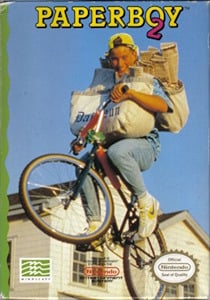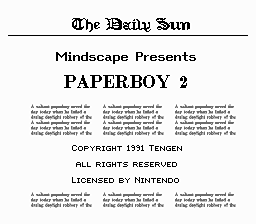
Paperboy 2 (1991-)
Developer: Tengen
Publisher: Mindscape
Genre: Action
Paperboy 2 for the NES was developed by Tengen and released in 1991, with Mindscape serving as its publisher for the console version. The game is a direct sequel to the original Paperboy, continuing the suburban newspaper delivery adventures with updated challenges and new features. Paperboy 2 was also released on other platforms including the Super NES, Game Boy, and various home computers, though the NES version remained a faithful adaptation of the arcade-style gameplay for home audiences.
In Paperboy 2, players again take on the role of a newspaper delivery person, this time facing new neighborhoods, obstacles, and tricks designed to increase difficulty. The game builds on the premise of delivering newspapers accurately while avoiding hazards such as cars, pedestrians, and construction zones. Its inspiration comes from the original Paperboy, retaining the charm of turning a mundane suburban task into an action-oriented challenge, while expanding the variety of hazards and stage layouts.
Gameplay involves maneuvering a bicycle along increasingly complex streets while throwing newspapers to subscribers’ homes. Timing and precision remain critical, as players must balance the need for speed with the accuracy required to maintain subscriptions. The NES version introduces new enemy types and environmental hazards compared to the first game, along with expanded level variety that rewards memorization and skill. Power-ups and bonus objectives add additional strategic elements, giving players reasons to replay stages for higher scores.
The soundtrack features energetic music that complements the hectic action of navigating suburban streets, with sound effects emphasizing collisions, newspaper throws, and environmental interactions. While Paperboy 2 did not have a direct NES sequel, it extended the franchise’s presence into the 1990s on multiple platforms. Promotion focused on its familiar yet expanded gameplay, highlighting the sequel’s new neighborhoods and challenges. Reception was generally positive, with reviewers praising its faithful continuation of the original’s concept, though some noted that the NES hardware limited the game’s visual and audio fidelity compared to other versions.
Images from MobyGames
Buy Paperboy 2
Click one of the Ebay or Amazon buttons below to check the latest prices and purchase Paperboy 2 for the Nintendo Entertainment System.

Related Searches
Paperboy 2 NES Download
Paperboy 2 is available to purchase and download from a range of vendors. Always shop around...
Paperboy 2 NES Manual
Various repositories around the internet have scanned and archived a range of retro manuals. Search now to.....
Paperboy 2 NES Rom
We don't host or link to rom sites for this game. However, there are many sites out there that may be...
Paperboy 2 NES Walkthrough
Many sites - particularly YouTube - host a range of walkthrough videos to guide you in your quest to get...
Paperboy 2 NES Cheats
There are various sites out there that can offer cheat codes for games. Search now to find all available...
Paperboy 2 NES Controls
This information can often be obtained through the user manual. Alternatively there are many sites out there...
Paperboy 2 NES Release Date
The initial release date for Paperboy 2 is stated as some time during 1991. Other ports of the game may..
Paperboy 2 NES Review
There are many sites out there that have collated and documented historic reviews of this game. Search now...
Paperboy 2 Famicom
As a Nintendo Entertainment System release, this game was also likely also available on the Famicom. This....
Paperboy 2 NES Speedrun
There is now a community of competitive speedrunners who will try and gain the fastest possible time on their....








